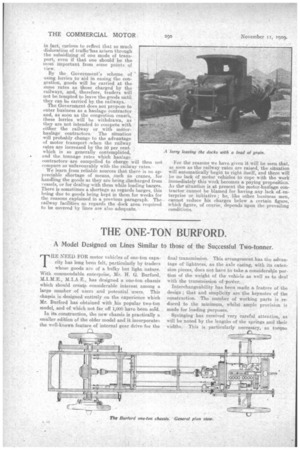THE TRUTH ABOUT DOCK CONGESTION.
Page 19

Page 20

If you've noticed an error in this article please click here to report it so we can fix it.
The Part which is Being Played by the Government Lorries.
ALTHOUGH the true reasons for the present .. congestion in our docks are probably known to persons intimately conversant with transport organization and its difficulties, there are many people who have totally wrong conceptions of the whole situation owing to the fact that the reasons have never been clearly stated or explained– certainly not by the daily Press: The main reason for the congestion is, of coarse, the shortage of railway rolling stock caused by the fact that much material was sent overseas, whilst the rest deteriorated owing to a shortage of the labour and materialneeessary for its proper overhaul and maintenance. As we have explained in previous issues, in consequence of the withdrawal of coastwise steamers, a large volume of traffic was diverted from sea to rail with the result that the railways are new burdened with traffic which they have not, as a rule, previously carried. In addition, the continued application of pre-w.ar rates to the carriage of goods by rail offers strong monetary inducements to traders and inanufacterers to use the railways for all goods which they can possibly leave lying at the docks .until such time as they can be transported by rail, and this in spite of the fact that they may receive plenty of offers from motor-haulage contractors to carry their goods, but necessarily at a higher rate—we say necessarily because motor transport is not subsidized by the Government as is railway transport and, naturally, the rates have had to be increased in order to make the running of motor Tehioles a commercial proposition.
The Government has alleviated the situation to a certain extent by giving directions to the railway eonsparties that no goods which have been impoited from abroad or which arc intended for foreign markets shall be carried by rail between points which can be effectively served; in whole Or part, by coastwise ser vices. For this purpose, schedules of traffic have been prepared, and all goods inclu,ded in such schedules are carried in whole or part coastwise, and the differences between the freights and charges so paid (other than demurrage), and the amounts of the railway rates and charges which would have been payable if the traffic had been carried by rail are refunded by the Railway Executive Committee or their s:gent to the traders by whom the payments have been made, providing that applications are laid within three months of the dates of forwarding the traffic,.
A considerable amount of the congestion is caused by lack of warehouse space, and goods are often kept in barges for weeks, paying demurrage until aecommodation is available in the warehouses. The congestion doe a not apply to any particular class of goods. Wool, timber and grain, tallow, tea and West Indian products, they all suffer from the same troubles springing from the same root causes. It is, in fact, curious to reflect that so much dislocation of traffic•has arisen through the subsidizing of one mode of transport, even if that one should be the most important from smile points qf view.
By the Government's scheme. of 118iTT lorries to aid in easing the congestion, goods will be carried at the same rates as those charged by the railways, and, therefore, traders will not be tempted to leave the goods until they can be carried by. the railways. The Government does not propose to enter business as a haulage contractor and, as soon as the congestion cease, these lorries will be withdrawn, as they are not intended to compete with either the railway or with motorhaulage contractors. The situation will probably change to the advantage of motor transport ,when the railway rates are increased by the 50 per cent. which is so generally contemplated, s and the tonnage rates which haulage contractors -are compelled to charge will then not • compare so unfavourably with the railway rates. We learn from reliable sources that there is no appreciable shortage of means, such as cranes, for handling the goods as they are being idiseharged from vessels, or for dealing with them while loading barges. i There s sometimes a shortage as regards barges, this being due to goods being kept in them for weeks for the reasons explained in a previous paragraph. The railway facilities as regards the dock area required to be covered by lines are also adequate, -For the reasons we have given it will be seen that, as soon as the railway rates are raised, the situation will automatically begin to right itself, and there will be no lack of motor vehicles to cope. with the work immediately this work becomes a paying proposition. As the situation is at present the motor-haulage cons tractor. cannot be blamed for having anylack of enterprise or. initiative ; he, like other .business men, cannot reduce his charges below a certain figure, which .figure, of course, depends upon the prevailing conditions.




























